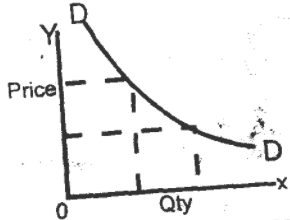is the measurement or degree or responsiveness of demand to changes in price. By this, we mean how consumers react to changes in price. Price elasticity coefficient (Ed) is measured as the percentage in quantity demanded divided by the percentage change in price.
Example: If there is 20% increase in price, which results to a1,out 0% fall in demand. Calculate the Percentage change in quantity demanded.
Note that there are three types of elasticity of demand.
- Price elasticity of demand
- Income elasticity of demand
- Cross elasticity of demand
PRICE ELASTICITY OF DEMAND
This is the degree of responsiveness of demand to slight changes in price.
TYPES OF PRICE ELASTICITY OF DEMAND
ELASTIC DEMAND:
This is a situation where the coefficient price elasticity of demand is greater than one.
i.e. PED > 1
Elastic demand is however sub-divided into two namely:-
Perfectly elastic demand: This occurs when a slight change in price causes a big change in the quantity demanded
Fairly elastic demand: This is when the demand curve gradually slopes downwards.
INELASTIC DEMAND:
This situation occurs when the price elastics of demand is less than one i.e. PED < 1 inelastic demand is equally subdivided into two namely:-
(a) Perfectly inelastic demand: This occurs when fairly considerable change n price does not affect the quantity demanded. The quantity demanded remains constant at whatever price.
(b) Fairly inelastic demand: demand cute slopes steeply.
UNITARY ELASTIC DEMAND
This occurs when a proportionate change in demand is equal to a proportionate change in price.
INCOME Elasticity OF DEMAND: This is the degree of responsiveness of demand to slight change in income.
The income elasticity of demand is subdivided into two:-
(a) Positive Income elasticity: This occurs when an increase in income brings about an increase in demand.
(b) Negative income elasticity: This occurs when an in demand, increase income brings about a decrease especially on inferior goods.
CROSS ELASTICITY OF DEMAND: This is equally the degree of responsiveness of demand of a commodity B to changes in the price of commodity. This situation is apparent with goods that are close substitutes.
FACTORS THAT AFFECT ELASTICITY OF DEMAND
- Consumers Income: The more a person earns, the less he complains about a rise in the price of commodities and vice-versa. Therefore, it is the poor people that complain bitterly about a rise in price.
- The possibility of close substitutes: In this case, goods that have close substitutes are very elastic in demand. “Garri and Akpu” are dose substitute, if the price of “garri” rises, more people will resort to buying “akpu” and vice-versa.
- Habit: If a person has developed a certain habit of expenditure for a particular commodity, it will be difficult for such a person to change even when the price of the commodities are rising. E.g tobacco or beer addicts.
- Influence of time.
- Luxurious goods.
